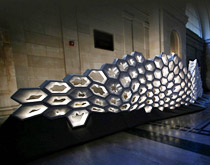Jeremy Ficca isn’t sure what to expect as he is led into the basement of Margaret Morrison. He was told that in the 1980s, movie director George Romero shot a scene for his cult horror film Creepshow here. Walking around the decrepit space, he can see why.
Ficca isn’t interested in making horror films. The new faculty member in the School of Architecture envisions something radically different for the basement’s future: a digital fabrication laboratory that will transform how students in the architecture program learn.

Four years later, the Digital Fabrication Lab is up and running, directed by Ficca. In it, students prepare for the digital realities of today’s architecture field by learning the latest two-and three-dimensional modeling and design software. They also have an interesting innovation partner: a high-tech robotic arm. Students program it to do advanced and highly customized jobs. One group of students used the robot to cut and carve 150 uniquely shaped plaster molds, which they then assembled into a wall.
To Ficca, robots are the industry’s future. As costs decrease, they will offer architects opportunities to do complex tasks otherwise inefficient and expensive, such as intricate carving, metal bending, and brick laying. In turn, they offer the designer more control and authority over final physical products, as opposed to just handing off designs for manufacturers and contractors to interpret.
In part for overseeing one of the few university programs in the world that incorporates robotics into digital fabrication, Ficca was recognized this year by ARCHITECT magazine of the American Institute of Architects as one of the top “Fab Four” architects leading the digital fabrication revolution.—Danielle Commisso (DC’06)
Related Links:
Fab Four



